Not all Calphalon Pans are dishwasher safe. Those made with nonstick, hard-anodized aluminum coats can be damaged by the harsh condition in the dishwasher. Also, other cookware and utensils in the dishwasher can easily scratch its nonstick surface. However, a stainless steel Calphalon pan is safe to clean in the dishwasher.
If you’re anything like me and get too busy in the kitchen to sort out pans for various cooking purposes, then you know how important it is to have a versatile pot on the rack.
This is why most of us have an undying love for the Calphalon cookware line. It’s got everything we need: a heavy-duty nonstick interior that can withstand high heat without sticking; a durable exterior that won’t chip or peel off when it’s time to wash it; and a sleek design that’s perfect for any kitchen.
But what if you want to use your Calphalon pans in the dishwasher? Is it safe?
The manufacturers state that it is dishwasher safe but go on to recommend hand washing, which I found weird like any other user. So I decided to find out more.
I took my favorite pan from the Calphalon collection (the Calphalon Classic Nonstick 12″ Round Cake Pan) and put it into the dishwasher with other dishes. After running the cycle, I removed the pan and inspected it. Unfortunately, It didn’t turn out well for me.
So, In this article, I’ll tell you all I found out about using Calphalon pans in the dishwasher and explain the best cleaning practices to keep the pans safe and durable.
Let’s get into the details!
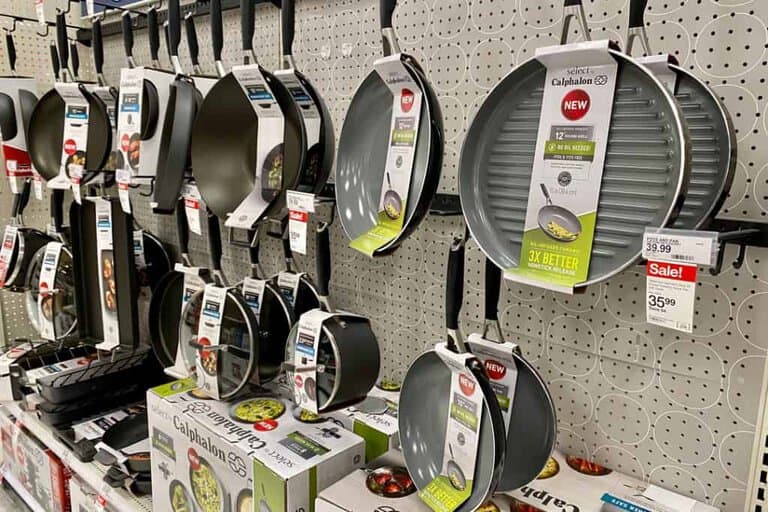
Are Calphalon Pans Dishwasher Safe?
Different Calphalon pots and pans are made from various materials, including cast iron, stainless steel, and hard-anodized aluminum. Some also have a regular cooking surface, while others have a nonstick coating.
This variation in materials and structure is what determines if your Calphalon Pan is safe in the dishwasher or not.
Based On Material
From my experience, cast iron and aluminum surface pans are not dishwasher safe. The harsh dishwasher detergents can damage the cast iron material and discolor the aluminum pan, causing it to lose its shine. A stainless steel pan, on the other hand, is dishwasher safe.
Based On Coating
Despite what some manufacturers claim, nonstick pans are usually not dishwasher safe. Dishwashing can cause the nonstick coating to peel, so it’s not worth the risk.
Now that you understand the role your Calphalon pan materials play in determining if its dishwasher is safe or not, you should be able to better decide how to clean them.
However, I’m not much of a risk taker when it comes to my cookware, so I don’t recommend washing the pan in the dishwasher at all. Instead, there is a better cleaning procedure which I’ll walk you through as you read on.
Why You Shouldn’t Clean Your Calphalon Pan In The Dishwasher
I wasn’t going to conclude that Calphalon pans are not dishwasher safe based on my experience only, so after consulting with other users and pro chefs, it does appear they also had bad experiences running the pan in the dishwasher.
Here are a few reasons why you should avoid putting your Calphalon Pan in the dishwasher:
- The dishwasher cleans with an abrasive and rough process. This is not an ideal environment for your cast iron and nonstick Calphalon pan.
- When you put a nonstick pan in the dishwasher, other cookware and utensils can come into contact with it and cause scratching. As a result, the rest of the coating may start to peel away, Making it unsafe for cooking and putting you at risk of several health problems.
- Also, the harsh dishwasher detergents can discolor or dull the aluminum surface of a Calphalon pan.
- Handwashing is a gentler method that will help to extend the life of your cookware more than dishwashing.
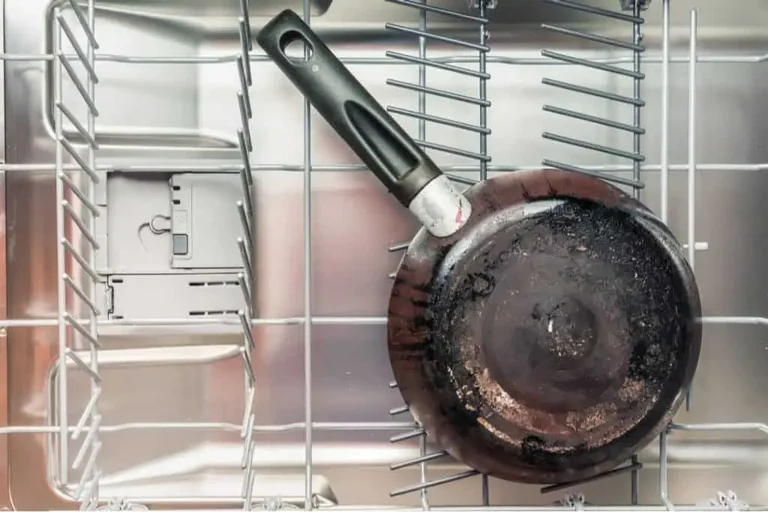
How To Clean And Care For Your Hard-Anodized Pans
Calphalon pans are more expensive than many other pot brands and need to be properly maintained to ensure you can enjoy them for years. Ideally, these pans can last up to ten years in your kitchen.
As I mentioned earlier, aside from your stainless steel Calphalon pan, which is dishwasher safe, hand washing your Calphalon pan is the best way to clean it.
So if you’re curious to know how to clean and care for your Calphalon cookware without having to worry about their appearance, follow the guidelines below to safely hand wash your Calphalon Pans.
Things You Will Need
- Warm Water
- Mild Detergent
- Soft Sponge/Brush
- Dishtowel
6 Steps For Cleaning Calphalon Pans
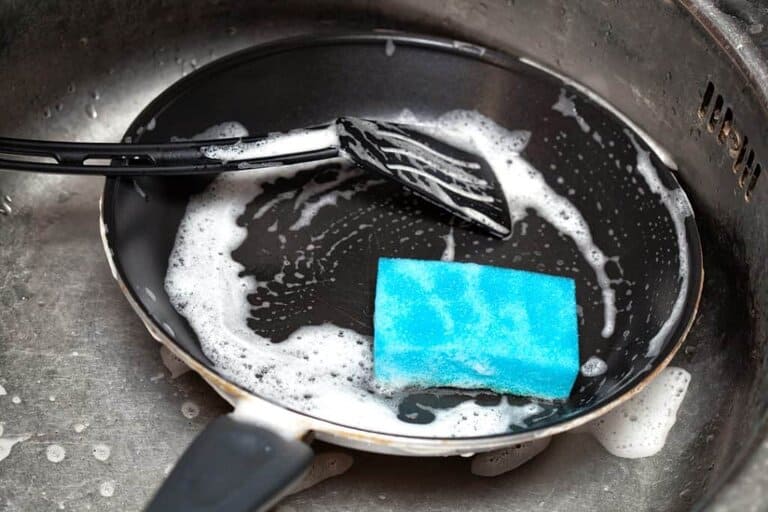
If you’ve got your materials in place, let’s get started with these six simple steps.
Step 1: Remove Food Items Immediately After Cooking
Leaving food on your Calphalon pan for an extended period after cooking can affect its shine and the food prepared in it. So, to get started:
- Make sure you remove your food items from the pan immediately after cooking and prepare to clean as soon as possible. Don’t allow food to sit on the nonstick surface for too long.
Step 2: Allow The Cookware To Completely Cool
Exposing your hot pan to sudden temperature change can cause thermal shock. So, always allow your pan to completely cool before washing it.
- Leave your pan to cool for at least 15 to 20 minutes before immersing in water.
- When you put a hot pan in cold water, it can cause warping and damage to your pan.
Step 3: Rinse Pan Under Running Water
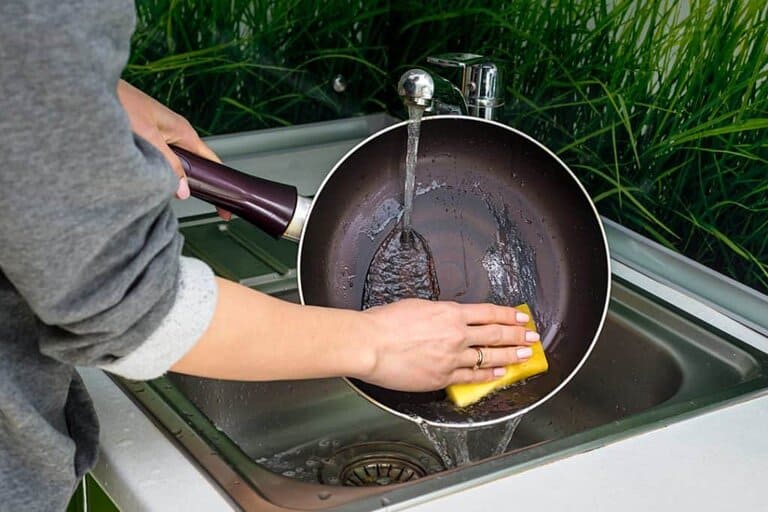
The next step is to rinse your pan to remove as many food particles as possible from the inside and outside of the pan. This will make washing the pan easier.
- As soon as the pan is cool, turn on the faucet and run water through the pan.
- Avoid using cold water to rinse your pan. Instead, use warm water to prevent the pot from warping.
- Then, rinse off as many food particles as possible before proceeding to the next step.
Step 4: Wash The Pan With Warm Water And Soap
After the food particles have been removed, it’s time to wash your pan with soap and water.
- Fill the sink halfway with warm water.
- Then, add a drop of liquid dish soap to the water. Use only mild detergents.
- Allow your cookware to soak in the warm water for 5 to 10 minutes before hand washing it. Do not soak or wash your pan with abrasive detergents or cleaners.
- Now, scrub your pan with a soft sponge or a soft bristle brush. Gently scrub the pan. Never use a metal brush on your pan to avoid damaging the coating.
- If the pan has food stuck to it, soak it in warm water for an additional 10 to 15 minutes to soften the stuck bits, and then scrub again.
Step 5: Thoroughly Rinse And Dry The Pan
After you’ve soaked and scrubbed your pan, It’s time to rinse it. At the end of the cleaning process, your pan should be free of any food, oil, or soap stains.
- Thoroughly rinse the pan to remove any remaining food and soap.
- Then, shake off any excess water and dry the pan with a dishtowel.
- Place the pan, upside down, on a clean counter to air dry.
Step 6: Store Your Pan In An Open Space
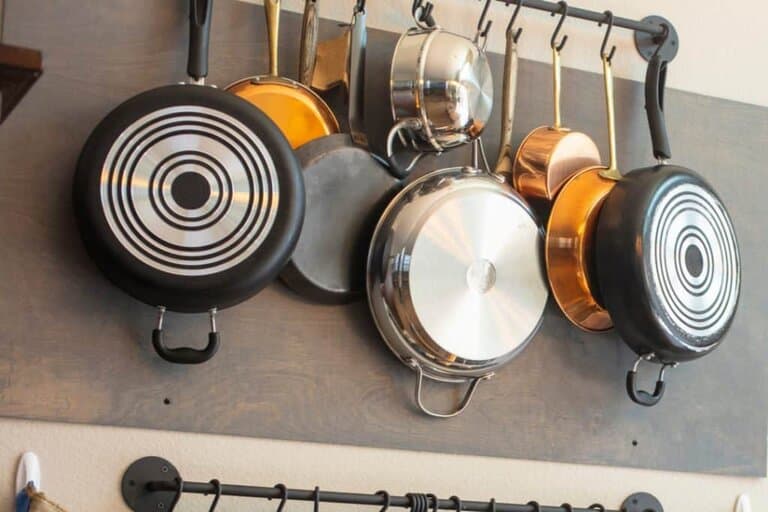
It is also important to store your pan properly. Keep your pan in a well-ventilated kitchen area to allow for fresh air and prevent scratches. I usually hang my nonstick Calphalon cookware on the dish rack.
- Allow the clean pan to completely dry before storing it.
- Don’t hang a wet pan with its lid to avoid rust and odor.
- Hang your pan on a vertical dish rack to allow it to get some fresh air.
- To avoid scratching the nonstick surface of your pan, do not stack it with other kitchen utensils.
How To Restore Your Damaged Calphalon Pans
Are your hard-anodized pans beginning to show signs of wear? Or is the Calphalon pan losing its non stick properties? These may be signs that your Calphalon pan is old and needs to be replaced.
However, if you feel yours is wearing out sooner than usual, it could be due to improper maintenance. Fortunately, you can still restore its shine and non stick properties.
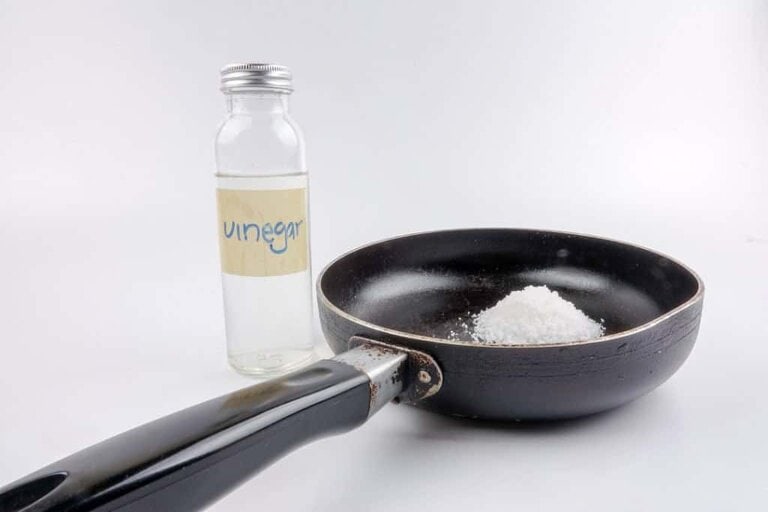
What You Will Need
- Baking powder
- White Vinegar
- Water
- Stovetop
- A soft sponge/brush
- Mild detergent
Whether your pot is burnt, sticky, or worn out, the following steps would help to restore its quality:
Step 1: Mix Vinegar And Baking Soda Solution
- Add 1 cup of water, 1/2 cup of white vinegar, and 2 tablespoons of baking soda to a bowl.
- Then, stir thoroughly to form a cleaning solution.
Step 2: Apply The Solution
- Fill your pan with the mixture.
- Then, place the pan on the stove and let it boil for 15 minutes to allow the burnt particles to fall off.
- You can also soak the pot overnight in just vinegar without heating it.
Step 3: Wash The Pan
- Allow the pan to cool before washing it.
- Scrub with a dish brush with a soft bristle.
- Then, rinse the solution off the pan and rewash it with mild soap and water.
- Now, rinse one more time to remove any remaining soap.
Step 4: Season The Pan
- Dry clean the pan with a dishtowel.
- Allow the pan to air dry for a few minutes.
- Then, re-season the pan by rubbing it with vegetable oil.
Tips for General Use and Care Of Calphalon Cookware
- Before using any new cookware, read the user manual and follow the cleaning and care instructions.
- By all means, avoid using metal utensils or any sharp object on the nonstick surface.
- Also, avoid using harsh or abrasive cleaners to clean your pan, and keep your pan out of the dishwasher as much as possible.
- Do not exceed the manufacturer’s maximum heat limit, which is typically 500 degrees Fahrenheit.
- Don’t leave burnt-on food particles on the nonstick surface for too long. It would affect the pan’s shine and lose its ability to properly cook your food.
- Sunlight can discolor the finish of your pans. If you live somewhere where direct sunlight is common, you might want to consider storing your pans in a dark cupboard.
- Avoid cutting fresh or acidic produce or meat inside the cookware.
- Consider polishing your pan if it begins to look dull after repeated use. You can restore your pan by following the steps outlined above. You could also use Bar Keepers Friend or Calphalon Cookware Cleanser. These products are recommended by Calphalon’s manufacturers.
FAQs On Can Calphalon Pans Go In The Dishwasher
Can I Use My Calphalon Pans In The Oven?
A Calphalon nonstick pan can be used in the oven as long as the temperature is not higher than 500 degrees Fahrenheit. But when the oven is set to broil, a Calphalon nonstick or cast iron pan cannot be used.
When Should I Replace My Calphalon Pan?
After 5 years of use, you should consider replacing your Calphalon pan with a new one. However, if the pan has a defect before the fifth year, you can return it to the manufacturer for a replacement; your warranty should cover that. And when the coating on your nonstick pan begins to peel, stop cooking with it.
What Utensils Can I Use With My Calphalon Pan?
The Calphalon cookware can be damaged by stainless steel spatulas and other metal objects. Hence, you should only use plastic, nylon, or wooden utensils. These materials are blunt enough and would not scratch the nonstick finish.
Is Calphalon Cookware Toxic?
Calphalon cookware is healthy. Its nonstick surface is made of non-reactive, PTFE- and PFOA-free hard-anodized aluminum materials. As a result, the pan doesn’t emit harmful chemicals into the food, even when heated to high temperatures.